Effects of Different Postharvest Precooling Treatments on Cold-Storage Quality of Yellow Peach (Amygdalus persica)
Abstract
:1. Introduction
2. Results
2.1. Respiratory Rate and Ethylene Production
2.2. Sensory Evaluation, Browning, Weight-Loss Rate, and Texture
2.3. Analysis by LF-NMR, Soluble-Solids Content, Titratable Acid Content, and Ascorbic Acid
2.4. Antioxidant-Related Enzyme Analysis
3. Discussion
3.1. Effects of Different Precooling Methods on Ethylene Production and Respiration Rate of Yellow Peaches
3.2. Effect of Different Precooling Methods on the Postharvest Quality of Yellow Peaches
3.3. Effects of Different Precooling Methods on the Antioxidant-Enzyme System of Yellow Peaches
4. Materials and Methods
4.1. Fruit Materials
4.2. Precooling Mode
- (i)
- SWPC: The centers of two yellow peaches were evenly dispersed at a 20 cm separation on shallow uncovered trays of 1.5 × 1.5 m, and were kept in a forced-air freezer at 4 °C, with an air speed of 8 m/s, for 40 min;
- (ii)
- CWPC: The yellow peaches were hydrocooled in 200 L rectangular plastic water tanks, and sodium hypochlorite (NaOCl) (5.65–6.00%; Fisher Scientific, Springfield, NJ) was added to water to produce a final concentration of 100 ± 2 or 200 ± 2 ppm active chlorine (HOCl). The pH values of the solutions were adjusted to 6.8 ± 0.05 using a 6 N HCl solution (Fisher Scientific, Springfield, NJ, United States of America). The yellow peaches were placed in sterilized cold water for 70 min, with the cold-water temperature always maintained at 4 °C at all times;
- (iii)
- VPC: The yellow peaches were kept in a VPC machine (VAC-0.2 type, Shanghai, China) for 260 min. The vacuum-cooler preset temperature was 4 °C, the water-spraying volumes were at 3%, and the final pressure was 580 Pa;
- (iv)
- RPC: The centers of two yellow peaches were evenly dispersed at a 20 cm separation in a shallow uncovered dish of 1.5 × 1.5 m, and were kept in a refrigerator at 4 °C for 130 min;
- (v)
- FIPC: The yellow peaches were kept in an ice slurry (ranging from −0.5 °C to −1.5 °C) for 80 min;
- (vi)
- CK: The yellow peaches without any precooling treatment after picking.
4.3. Sample Collecting
4.4. Respiratory Rate and Ethylene Production
4.5. Sensory Characteristics
4.6. Determination of Texture, Browning Index, and Weight-Loss Rate
4.7. Determination of Analysis by LF-NMR, Water Migration, Titratable Acidity, Soluble Solids, and Ascorbic Acid
4.8. Determination of Peroxidase (POD), Superoxide Dismutase (SOD), Phenylalanine Ammonia-Lyase (PAL), and Polyphenol Oxidase (PPO) Activities
4.9. Data Analysis
5. Conclusions
Author Contributions
Funding
Data Availability Statement
Conflicts of Interest
References
- Wu, Q.; Shen, C.; Li, J.; Wu, D.; Chen, K. Application of indirect plasma-processed air on microbial inactivation and quality of yellow peaches during storage. Innov. Food Sci. Emerg. Technol. 2022, 79, 103044. [Google Scholar] [CrossRef]
- Adaskaveg, J.E.; Schnabel, G.; Förster, H. The Peach: Botany, Production and Uses. 2008. Available online: https://www.sciencedirect.com/science/article/pii/S0304423809001204 (accessed on 23 June 2022).
- Kibar, H.; Taş, A.; Gündoğdu, M. Evaluation of biochemical changes and quality in peach fruit: Effect of putrescine treatments and storage. J. Food Compos. Anal. 2021, 102, 104048. [Google Scholar] [CrossRef]
- Zhu, L.; Du, H.; Wang, W.; Zhang, W.; Shen, Y.; Wan, C.; Chen, J. Synergistic effect of nitric oxide with hydrogen sulfide on inhibition of ripening and softening of peach fruits during storage. Sci. Hortic. 2019, 256, 108591. [Google Scholar] [CrossRef]
- Zhang, Y.; Gong, Y.; Chen, L.; Peng, Y.; Wang, Q.; Shi, J. Hypotaurine delays senescence of peach fruit by regulating reactive oxygen species metabolism. Sci. Hortic. 2019, 253, 295–302. [Google Scholar] [CrossRef]
- Wang, Q.; Wei, Y.; Jiang, S.; Wang, X.; Xu, F.; Wang, H.; Shao, X. Flavor development in peach fruit treated with 1-methylcyclopropene during shelf storage. Food Res. Int. 2020, 137, 109653. [Google Scholar] [CrossRef] [PubMed]
- Zhu, L.; Yu, H.; Dai, X.; Yu, M.; Yu, Z. Effect of methyl jasmonate on the quality and antioxidant capacity by modulating ascorbate-glutathione cycle in peach fruit. Sci. Hortic. 2022, 303, 111216. [Google Scholar] [CrossRef]
- Gruyters, W.; Defraeye, T.; Verboven, P.; Berry, T.; Nicolai, B. Reusable boxes for a beneficial apple cold chain: A precooling analysis. Int. J. Refrig. 2019, 106, 338–349. [Google Scholar] [CrossRef]
- Zhu, Z.; Geng, Y.; Sun, D.W. Effects of Operation Processes and Conditions on Enhancing Performances of Vacuum Cooling of Foods: A Review. Trends Food Sci. Technol. 2019, 85, 67–77. [Google Scholar] [CrossRef]
- Elansari, A.M.; Fenton, D.L.; Callahan, C.W. Chapter 6—Precooling. In Postharvest Technology of Perishable Horticultural Commodities; Yahia, E.M., Ed.; Woodhead Publishing: Sawston, UK, 2019; pp. 161–207. [Google Scholar] [CrossRef]
- Makule, E.; Dimoso, N.; Tassou, S.A. Precooling and Cold Storage Methods for Fruits and Vegetables in Sub-Saharan Africa—A Review. Horticulturae 2022, 8, 776. [Google Scholar] [CrossRef]
- de Oliveira Alves Sena, E.; Da Silva, P.S.O.; De Araujo, H.G.S.; De Aragão Batista, M.C.; Matos, P.N.; Sargent, S.A.; De Oliveira Junior, L.F.G.; Carnelossi, M.A.G. Postharvest quality of cashew apple after hydrocooling and coold room. Postharvest Biol. Technol. 2019, 155, 65–71. [Google Scholar] [CrossRef]
- Liang, Y.S.; Wongmetha, O.; Wu, P.S.; Ke, L.S. Influence of hydrocooling on browning and quality of litchi cultivar Feizixiao during storage. Int. J. Refrig. 2013, 36, 1173–1179. [Google Scholar] [CrossRef]
- Xuan, J.; Yang, G.; Zhenfeng, G.; Xinxian, Z.; Zhihong, F.; Lixin, Z.; Yuhao, B. Improving quality and antioxidant capacity of nectarine by forced-air precooling during storage and transportation. Food Ferment. Ind. 2020, 22, 173–179. [Google Scholar]
- Pervitasari, A.N.; Kim, J.H.; Cho, K.; Choi, D.; Yun, S.K.; Kim, D.; Kim, D.H.; Kim, J. Effects of Hydrocooling and 1-MCP Treatment on the Quality Changes of Peach Fruit during Storage. Hortic. Sci. Technol. 2021, 39, 769–780. [Google Scholar] [CrossRef]
- Caprioli, I.; Lafuente, M.T.; Rodrigo, M.J.; Mencarelli, F. Influence of Postharvest Treatments on Quality, Carotenoids, and Abscisic Acid Content of Stored “Spring Belle” Peach (Prunus persica) Fruit. J. Agric. Food Chem. 2009, 57, 7056–7063. [Google Scholar] [CrossRef]
- Garrido, Y.; Tudela, J.A.; Gil, M.I. Comparison of industrial precooling systems for minimally processed baby spinach. Postharvest Biol. Technol. 2015, 102, 1–8. [Google Scholar] [CrossRef]
- He, Y.; Fan, G.-J.; Wu, C.-E.; Kou, X.; Li, T.-T.; Tian, F.; Gong, H. Influence of packaging materials on postharvest physiology and texture of garlic cloves during refrigeration storage. Food Chem. 2019, 298, 125019. [Google Scholar] [CrossRef] [PubMed]
- Wei, S.; Mei, J.; Xie, J. Effects of Edible Coating and Modified Atmosphere Technology on the Physiology and Quality of Mangoes after Low-Temperature Transportation at 13 °C in Vibration Mitigation Packaging. Plants 2021, 10, 2432. [Google Scholar] [CrossRef]
- Ren, Y.-y.; Sun, P.-p.; Wang, X.-x.; Zhu, Z.-y. Degradation of cell wall polysaccharides and change of related enzyme activities with fruit softening in Annona squamosa during storage. Postharvest Biol. Technol. 2020, 166, 111203. [Google Scholar] [CrossRef]
- Kirtil, E.; Oztop, M.H.; Sirijariyawat, A.; Ngamchuachit, P.; Barrett, D.M.; McCarthy, M.J. Effect of pectin methyl esterase (PME) and CaCl2 infusion on the cell integrity of fresh-cut and frozen-thawed mangoes: An NMR relaxometry study. Food Res. Int. 2014, 66, 409–416. [Google Scholar] [CrossRef]
- Kovács, A.J.; Neményi, M. Moisture gradient vector calculation as a new method for evaluating NMR images of corn (Zea mays L.) kernels during drying. Magn. Reson. Imaging 1999, 17, 1077–1082. [Google Scholar] [CrossRef]
- Ma, X.; Mei, J.; Xie, J. Effects of multi-frequency ultrasound on the freezing rates, quality properties and structural characteristics of cultured large yellow croaker (Larimichthys crocea). Ultrason. Sonochem. 2021, 76, 105657. [Google Scholar] [CrossRef] [PubMed]
- Shinya, P.; Contador, L.; Frett, T.; Infante, R. Effect of prolonged cold storage on the sensory quality of peach and nectarine. Postharvest Biol. Technol. 2014, 95, 7–12. [Google Scholar] [CrossRef]
- Song, C.; Zhao, Y.; Li, A.; Qi, S.; Lin, Q.; Duan, Y. Postharvest nitric oxide treatment induced the alternative oxidase pathway to enhance antioxidant capacity and chilling tolerance in peach fruit. Plant Physiol. Biochem. 2021, 167, 113–122. [Google Scholar] [CrossRef] [PubMed]
- Luo, Z.; Chen, C.; Xie, J. Effect of salicylic acid treatment on alleviating postharvest chilling injury of ‘Qingnai’ plum fruit. Postharvest Biol. Technol. 2011, 62, 115–120. [Google Scholar] [CrossRef]
- De Oliveira, K.Á.R.; Berger, L.R.R.; De Araújo, S.A.; Câmara, M.P.S.; De Souza, E.L. Synergistic mixtures of chitosan and Mentha piperita L. essential oil to inhibit Colletotrichum species and anthracnose development in mango cultivar Tommy Atkins. Food Microbiol. 2017, 66, 96–103. [Google Scholar] [CrossRef] [PubMed]
- Alique, R.; Martínez, M.; Alonso, J. Metabolic response to two hydrocooling temperatures in sweet cherries cv Lapins and cv Sunburst. J. Sci. Food Agric. 2006, 86, 1847–1854. [Google Scholar] [CrossRef]
- Giné-Bordonaba, J.; Eduardo, I.; Arús, P.; Cantín, C.M. Biochemical and genetic implications of the slow ripening phenotype in peach fruit. Sci. Hortic. 2020, 259, 108824. [Google Scholar] [CrossRef]
- Naji, S.; Razavi, S.M.A. Functional and textural characteristics of cress seed (Lepidium sativum) gum and xanthan gum: Effect of refrigeration condition. Food Biosci. 2014, 5, 1–8. [Google Scholar] [CrossRef]
- Zhao, Y.; Zhu, X.; Hou, Y.; Pan, Y.; Shi, L.; Li, X. Effects of harvest maturity stage on postharvest quality of winter jujube (Zizyphus jujuba Mill. cv. Dongzao) fruit during cold storage. Sci. Hortic. 2021, 277, 109778. [Google Scholar] [CrossRef]
- Melo, A.A.M.; Olabode, P.N.; Michael, B.C.; Prakash, A. Causes of irradiation-induced softening in peaches. Radiat. Phys. Chem. 2018, 152, 107–113. [Google Scholar] [CrossRef]
- Angeletti, P.; Castagnasso, H.; Miceli, E.; Terminiello, L.; Concellón, A.; Chaves, A.; Vicente, A.R. Effect of preharvest calcium applications on postharvest quality, softening and cell wall degradation of two blueberry (Vaccinium corymbosum) varieties. Postharvest Biol. Technol. 2010, 58, 98–103. [Google Scholar] [CrossRef]
- Cantín, C.M.; Minas, I.S.; Goulas, V.; Jiménez, M.; Manganaris, G.A.; Michailides, T.J.; Crisosto, C.H. Sulfur dioxide fumigation alone or in combination with CO2-enriched atmosphere extends the market life of highbush blueberry fruit. Postharvest Biol. Technol. 2012, 67, 84–91. [Google Scholar] [CrossRef]
- Paniagua, A.C.; East, A.R.; Hindmarsh, J.P.; Heyes, J.A. Moisture loss is the major cause of firmness change during postharvest storage of blueberry. Postharvest Biol. Technol. 2013, 79, 13–19. [Google Scholar] [CrossRef]
- Mukama, M.; Ambaw, A.; Berry, T.M.; Opara, U.L. Analysing the dynamics of quality loss during precooling and ambient storage of pomegranate fruit. J. Food Eng. 2019, 245, 166–173. [Google Scholar] [CrossRef]
- Kaur, M.; Kaur, A. Improvement in storability and quality of peach cv. Flordaprince with post-harvest application of various chemicals. J. Pharmacogn. Phytochem. 2019, 8, 460–464. [Google Scholar]
- Zainal, B.; Ding, P.; Ismail, I.S.; Saari, N. Physico-chemical and microstructural characteristics during postharvest storage of hydrocooled rockmelon (Cucumis melo L. reticulatus cv. Glamour). Postharvest Biol. Technol. 2019, 152, 89–99. [Google Scholar] [CrossRef]
- Bartz, J.A.; Brecht, J.K. Postharvest Physiology and Pathology of Vegetables; CRC Press: Boca Raton, FL, USA, 2002; Volume 123. [Google Scholar]
- Kongwong, P.; Boonyakiat, D.; Poonlarp, P. Extending the shelf life and qualities of baby cos lettuce using commercial precooling systems. Postharvest Biol. Technol. 2019, 150, 60–70. [Google Scholar] [CrossRef]
- Sun, D.-W.; Zheng, L. Vacuum cooling technology for the agri-food industry: Past, present and future. J. Food Eng. 2006, 77, 203–214. [Google Scholar] [CrossRef]
- Petriccione, M.; Pagano, L.; Forniti, R.; Zampella, L.; Mastrobuoni, F.; Scortichini, M.; Mencarelli, F. Postharvest treatment with chitosan affects the antioxidant metabolism and quality of wine grape during partial dehydration. Postharvest Biol. Technol. 2018, 137, 38–45. [Google Scholar] [CrossRef]
- Lai, J.; Cao, X.; Yu, T.; Wang, Q.; Zhang, Y.; Zheng, X.; Lu, H. Effect of Cryptococcus laurentii on inducing disease resistance in cherry tomato fruit with focus on the expression of defense-related genes. Food Chem. 2018, 254, 208–216. [Google Scholar] [CrossRef]
- Albertini, M.-V.; Carcouet, E.; Pailly, O.; Gambotti, C.; Luro, F.; Berti, L. Changes in organic acids and sugars during early stages of development of acidic and acidless citrus fruit. J. Agric. Food Chem. 2006, 54, 8335–8339. [Google Scholar] [CrossRef]
- Moneruzzaman, K.; Hossain, A.; Sani, W.; Saifuddin, M.; Alenazi, M. Effect of harvesting and storage conditions on the post harvest quality of tomato (Lycopersicon esculentum Mill.) cv. Roma VF. Aust. J. Crop Sci. 2009, 3, 113. [Google Scholar]
- Hanif, A.; Ahmad, S.; Jaskani, M.J.; Ahmad, R. Papaya treatment with putrescine maintained the overall quality and promoted the antioxidative enzyme activities of the stored fruit. Sci. Hortic. 2020, 268, 109367. [Google Scholar] [CrossRef]
- Reina, L.; Fleming, H.; Humphries, E. Microbial control of cucumber hydro-cooling water with chlorine dioxide. J. Food Prot. 1995, 58, 451–456. [Google Scholar] [CrossRef] [PubMed]
- Zhang, C.; Chen, K.; Wang, G. Combination of the biocontrol yeast Cryptococcus laurentii with UV-C treatment for control of postharvest diseases of tomato fruit. BioControl 2013, 58, 269–281. [Google Scholar] [CrossRef]
- Khairi, A.N.; Falah, M.A.F.; Suyantohadi, A.; Takahashi, N.; Nishina, H. Effect of Storage Temperatures on Color of Tomato Fruit (Solanum lycopersicum Mill.) Cultivated under Moderate Water Stress Treatment. Agric. Agric. Sci. Procedia 2015, 3, 178–183. [Google Scholar] [CrossRef]
- Feng, Y.; Liu, Q.; Liu, P.; Shi, J.; Wang, Q. Aspartic Acid Can Effectively Prevent the Enzymatic Browning of Potato by Regulating the Generation and Transformation of Brown Product. Postharvest Biol. Technol. 2020, 166, 111209. [Google Scholar] [CrossRef]
- Ma, L.; Zhang, M.; Bhandari, B.; Gao, Z. Recent developments in novel shelf life extension technologies of fresh-cut fruits and vegetables. Trends Food Sci. Technol. 2017, 64, 23–38. [Google Scholar] [CrossRef]
- Wang, Q.; Cao, Y.; Zhou, L.; Jiang, C.-Z.; Feng, Y.; Wei, S. Effects of postharvest curing treatment on flesh colour and phenolic metabolism in fresh-cut potato products. Food Chem. 2015, 169, 246–254. [Google Scholar] [CrossRef]
- Jiang, J.; Gong, L.; Dong, Q.; Kang, Y.; Osako, K.; Li, L. Characterization of PLA-P3,4HB active film incorporated with essential oil: Application in peach preservation. Food Chem. 2020, 313, 126134. [Google Scholar] [CrossRef]
- Liu, X.; Yang, Q.; Lu, Y.; Li, Y.; Li, T.; Zhou, B.; Qiao, L. Effect of purslane (Portulaca oleracea L.) extract on anti-browning of fresh-cut potato slices during storage. Food Chem. 2019, 283, 445–453. [Google Scholar] [CrossRef] [PubMed]
- Tinello, F.; Lante, A. Recent advances in controlling polyphenol oxidase activity of fruit and vegetable products. Innov. Food Sci. Emerg. Technol. 2018, 50, 73–83. [Google Scholar] [CrossRef]
- Gao, H.; Zeng, Q.; Ren, Z.; Li, P.; Xu, X. Effect of exogenous γ-aminobutyric acid treatment on the enzymatic browning of fresh-cut potato during storage. J. Food Sci. Technol. 2018, 55, 5035–5044. [Google Scholar] [CrossRef] [PubMed]
- Pristijono, P.; Wills, R.B.H.; Golding, J.B. Inhibition of browning on the surface of apple slices by short term exposure to nitric oxide (NO) gas. Postharvest Biol. Technol. 2006, 42, 256–259. [Google Scholar] [CrossRef]
- Rasouli, H.; Farzaei, M.H.; Mansouri, K.; Mohammadzadeh, S.; Khodarahmi, R. Plant cell cancer: May natural phenolic compounds prevent onset and development of plant cell malignancy? A literature review. Molecules 2016, 21, 1104. [Google Scholar] [CrossRef]
- Brackmann, A.; Weber, A.; Giehl, R.; Eisermann, A.C. Pre-cooling on ‘Chiripa’ peaches quality/Pre-resfriamento sobre a qualidade de pessegos ‘Chiripa’. Ciência Rural 2009, 39, 2354–2360. [Google Scholar] [CrossRef]
- De Oliveira Alves Sena, E.; Oliveira da Silva, P.S.; De Aragão Batista, M.C.; Alonzo Sargent, S.; Ganassali de Oliveira Junior, L.F.; Almeida Castro Pagani, A.; Gutierrez Carnelossi, M.A. Calcium application via hydrocooling and edible coating for the conservation and quality of cashew apples. Sci. Hortic. 2019, 256, 108531. [Google Scholar] [CrossRef]
- Nguyen, T.T.; Uthairatanakij, A.; Srilaong, V.; Laohakunjit, N.; Kato, M.; Jitareerat, P. Impact of electron beam irradiation on the chlorophyll degradation and antioxidant capacity of mango fruit. Appl. Biol. Chem. 2021, 64, 19. [Google Scholar] [CrossRef]
- Jongsri, P.; Rojsitthisak, P.; Wangsomboondee, T.; Seraypheap, K. Influence of chitosan coating combined with spermidine on anthracnose disease and qualities of ‘Nam Dok Mai’ mango after harvest. Sci. Hortic. 2017, 224, 180–187. [Google Scholar] [CrossRef]
- Zhang, Z.; Zhu, Q.; Hu, M.; Gao, Z.; An, F.; Li, M.; Jiang, Y. Low-temperature conditioning induces chilling tolerance in stored mango fruit. Food Chem. 2017, 219, 76–84. [Google Scholar] [CrossRef]
- Kumar, N.; Petkoska, A.T.; AL-Hilifi, S.A.; Fawole, O.A. Effect of Chitosan–Pullulan Composite Edible Coating Functionalized with Pomegranate Peel Extract on the Shelf Life of Mango (Mangifera indica). Coatings 2021, 11, 764. [Google Scholar] [CrossRef]
- Liu, Y.; Ge, Y.; Bi, Y.; Li, C.; Deng, H.; Hu, L.; Dong, B. Effect of postharvest acibenzolar-S-methyl dipping on phenylpropanoid pathway metabolism in muskmelon (Cucumis melo L.) fruits. Sci. Hortic. 2014, 168, 113–119. [Google Scholar] [CrossRef]
- Gheysarbigi, S.; Mirdehghan, S.H.; Ghasemnezhad, M.; Nazoori, F. The inhibitory effect of nitric oxide on enzymatic browning reactions of in-package fresh pistachios (Pistacia vera L.). Postharvest Biol. Technol. 2020, 159, 110998. [Google Scholar] [CrossRef]
- Zhu, S.; Liu, M.; Zhou, J. Inhibition by nitric oxide of ethylene biosynthesis and lipoxygenase activity in peach fruit during storage. Postharvest Biol. Technol. 2006, 42, 41–48. [Google Scholar] [CrossRef]
- Palou, E.; Lopez-Malo, A.; Barbosa-Canovas, G.V.; Welti-Chanes, J.; Swanson, B.G. Polyphenoloxidase activity and color of blanched and high hydrostatic pressure treated banana puree. J. Food Sci. 1999, 64, 42–45. [Google Scholar] [CrossRef]
- Bai, X.-y.; Yang, Z.-m.; Shen, W.-j.; Shao, Y.-z.; Zeng, J.-k.; Li, W. Polyphenol treatment delays the browning of litchi pericarps and promotes the total antioxidant capacity of litchi fruit. Sci. Hortic. 2022, 291, 110563. [Google Scholar] [CrossRef]
- Zhang, Y.; Xie, J. The effect of red and violet light emitting diode (LED) treatments on the postharvest quality and biodiversity of fresh-cut pakchoi (Brassica rapa L. Chinensis). Food Sci. Technol. Int. 2021, 28, 108201322110188. [Google Scholar] [CrossRef]
- Lafarga, T.; Bobo, G.; Viñas, I.; Zudaire, L.; Simó, J.; Aguiló-Aguayo, I. Steaming and sous-vide: Effects on antioxidant activity, vitamin C, and total phenolic content of Brassica vegetables. Int. J. Gastron. Food Sci. 2018, 13, 134–139. [Google Scholar] [CrossRef]
- Lo’ay, A.A.; Taher, M.A. Effectiveness salicylic acid blending in chitosan/PVP biopolymer coating on antioxidant enzyme activities under low storage temperature stress of ‘Banati’ guava fruit. Sci. Hortic. 2018, 238, 343–349. [Google Scholar] [CrossRef]
- Adhikary, T.; Gill, P.P.S.; Jawandha, S.K.; Bhardwaj, R.D.; Anurag, R.K. Efficacy of postharvest sodium nitroprusside application to extend storability by regulating physico-chemical quality of pear fruit. Food Chem. 2021, 346, 128934. [Google Scholar] [CrossRef]
- Shi, Z.; Wang, F.; Lu, Y.; Deng, J. Combination of chitosan and salicylic acid to control postharvest green mold caused by Penicillium digitatum in grapefruit fruit. Sci. Hortic. 2018, 233, 54–60. [Google Scholar] [CrossRef]
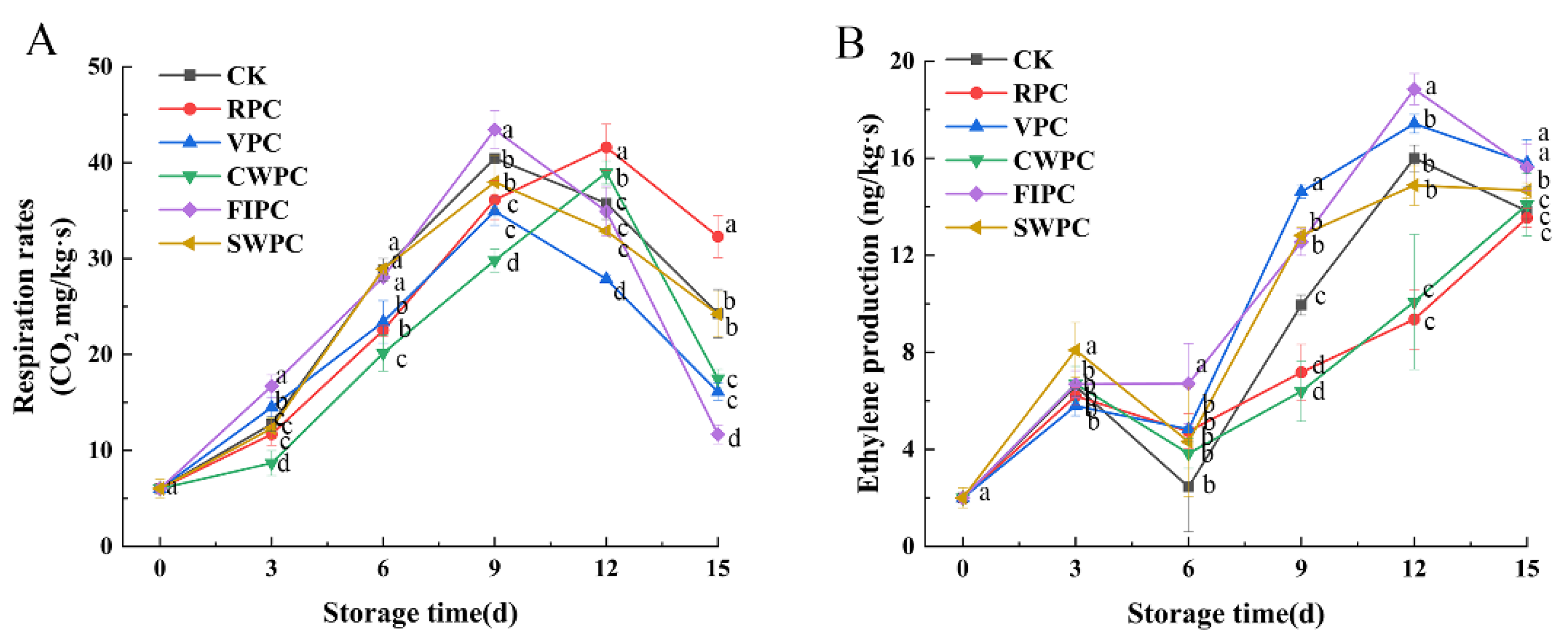
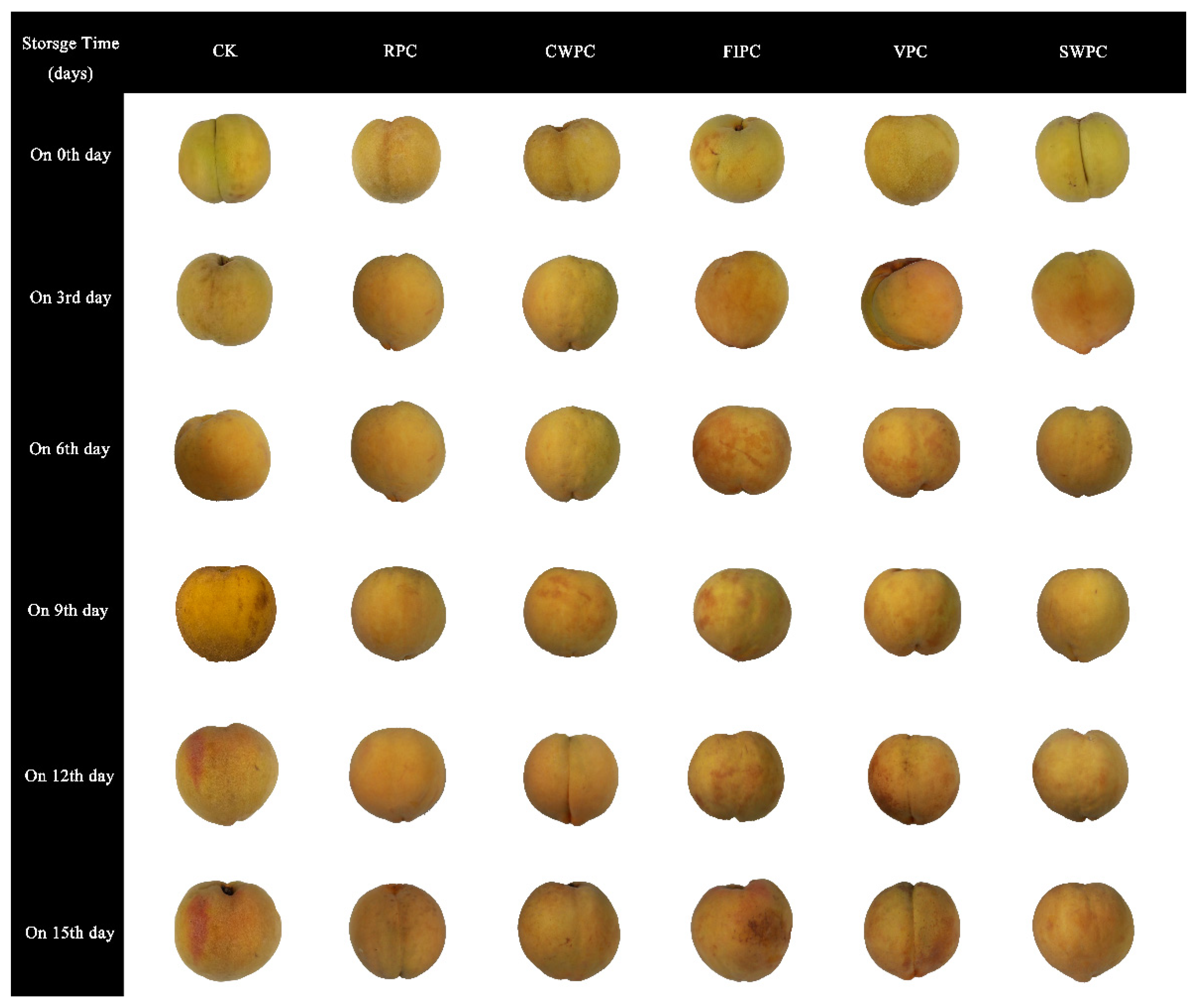

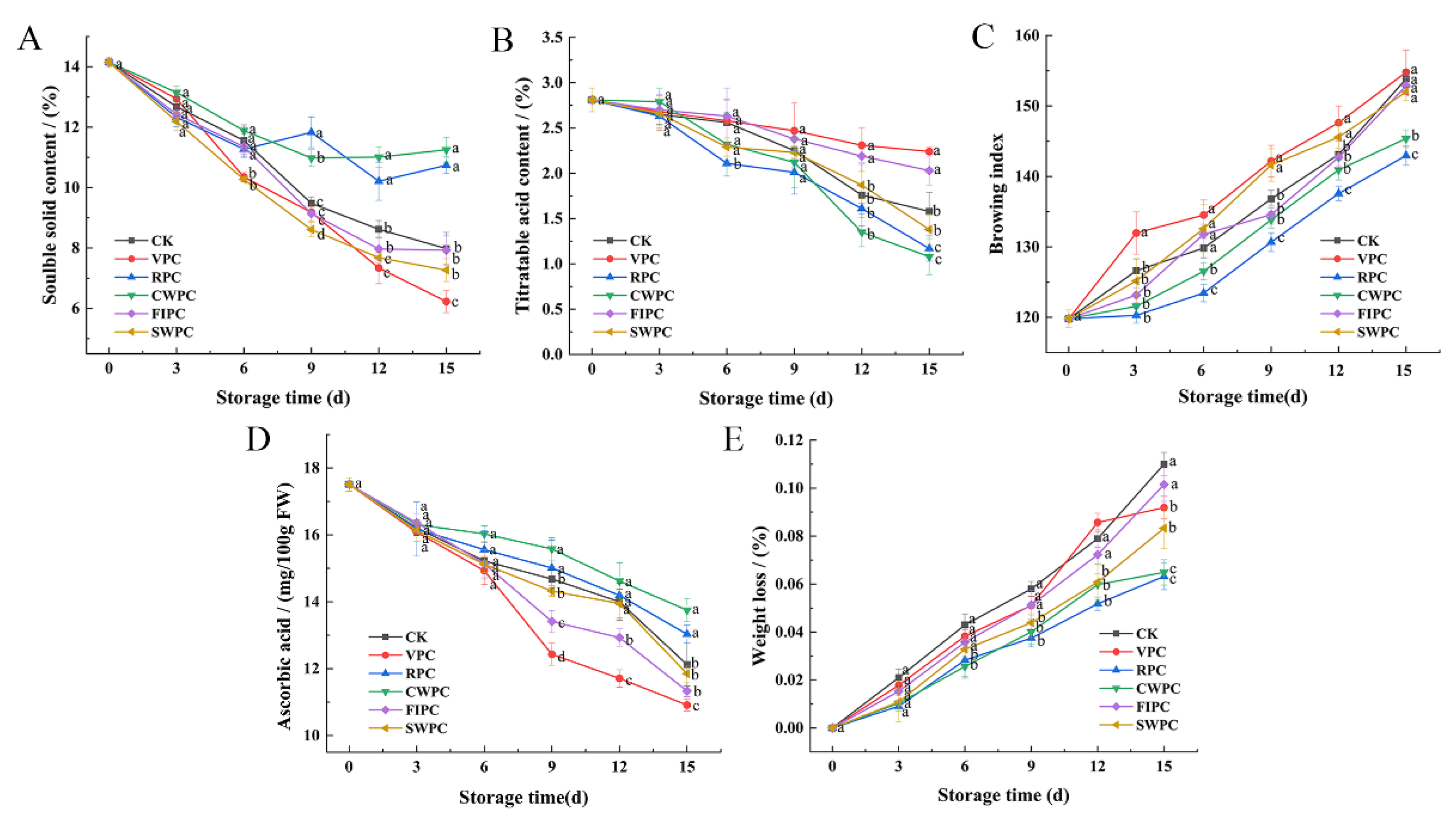
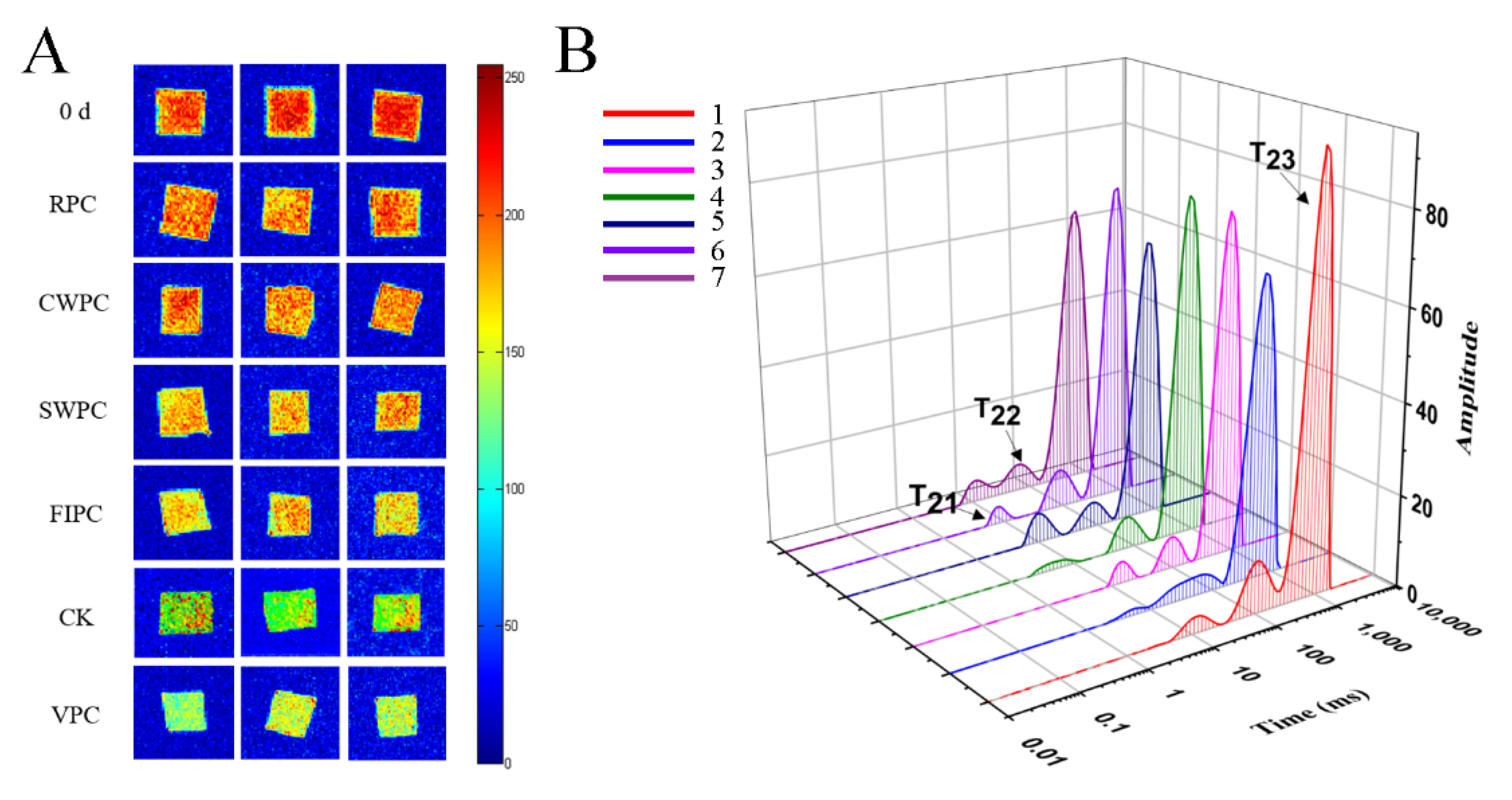
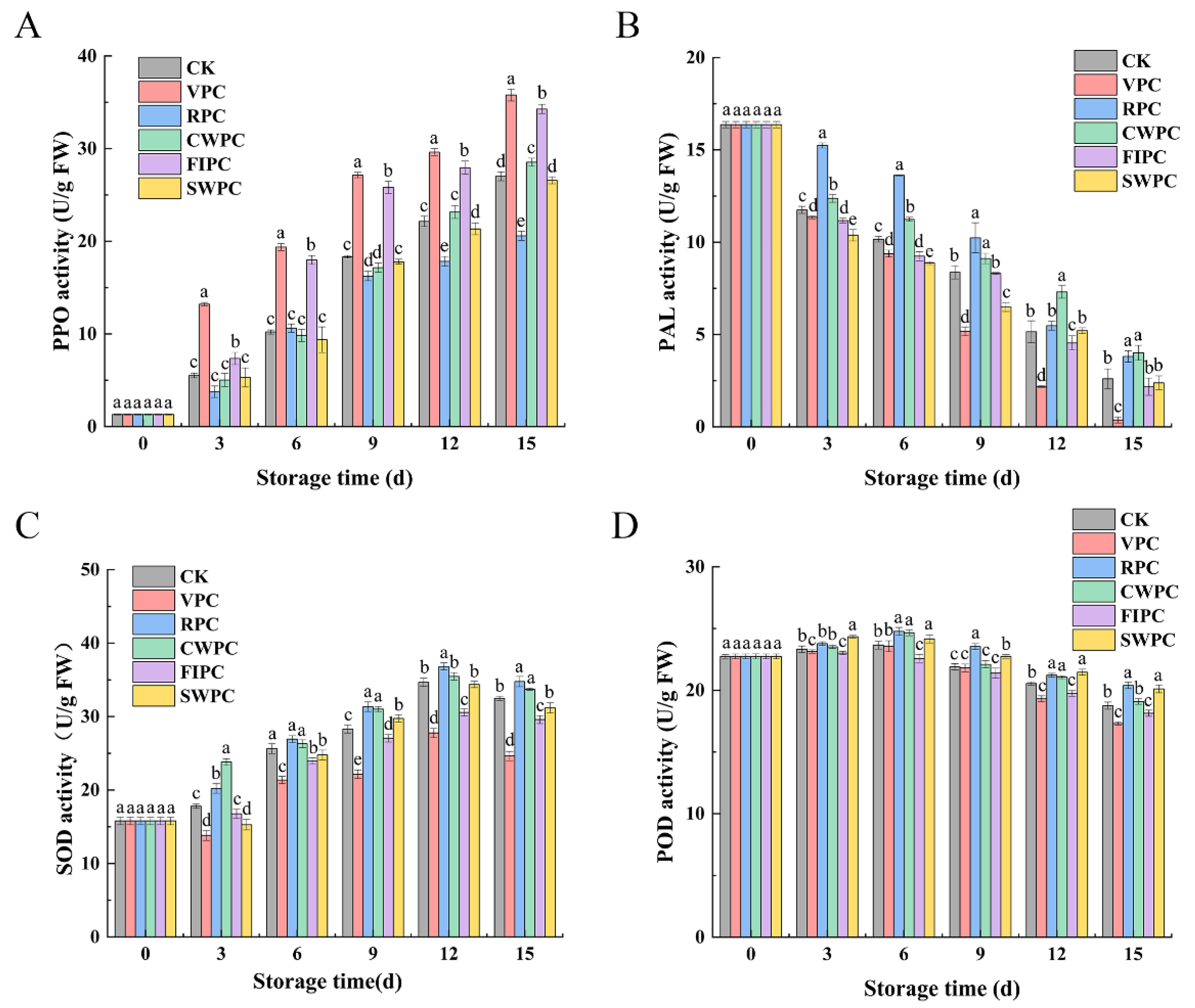
| Hardness | Adhesiveness | Springiness | Cohesiveness | Chewiness | |
|---|---|---|---|---|---|
| 0d | 3015.33 ± 848.92 a | −10.28 ± 5.24 a | 0.52 ± 0.20 ab | 0.20 ± 0.02 a | 333.51 ± 183.75 a |
| CK | 855.3 ± 132.3 c | −30.29 ± 13.14 ab | 0.60 ± 0.12 ab | 0.17 ± 0.03 a | 72.18 ± 12.12 b |
| RPC | 1527.22 ± 202.64 b | −31.78 ± 15.21 ab | 0.58 ± 0.09 ab | 0.20 ± 0.03 a | 181.07 ± 64.69 b |
| CWPC | 1088.70 ± 114.18 bc | −23.74 ± 14.23 ab | 0.43 ± 0.18 b | 0.17 ± 0.03 a | 75.89 ± 16.23 b |
| SWPC | 712.18 ± 121.31 c | −31.42 ± 7.19 ab | 0.64 ± 0.05 ab | 0.17 ± 0.03 a | 73.17 ± 6.42 b |
| FIPC | 655.42 ± 38.13 c | −36.72 ± 8.36 b | 0.76 ± 0.09 a | 0.16 ± 0.02 a | 78.50 ± 4.46 b |
| VPC | 500.80 ± 53.43 c | −29.89 ± 17.76 ab | 0.70 ± 0.21 ab | 0.15 ± 0.03 a | 58.12 ± 29.73 b |
| Score | Color | Texture | Smell |
|---|---|---|---|
| 10 | Full and bright color | Crisp | Refreshing fragrance |
| 8 | Color is a bit dim | It is brittle, but it does not shrink. | No fragrance, no peculiar smell |
| 6 | Overall acceptable; color is a little dark with small spots. | Slight atrophy | No fragrance, slightly peculiar smell after careful smelling |
| 4 | Browning rate < 1/3 | Obvious atrophy, but not serious. | Obvious odor, but not serious |
| 2 | Browning rate 1/3 | Serious atrophy | Severe odor |
| 0 | All browning, and the color of mildew spots can be seen. | All severely atrophied and moldy. | Stench |
Publisher’s Note: MDPI stays neutral with regard to jurisdictional claims in published maps and institutional affiliations. |
© 2022 by the authors. Licensee MDPI, Basel, Switzerland. This article is an open access article distributed under the terms and conditions of the Creative Commons Attribution (CC BY) license (https://creativecommons.org/licenses/by/4.0/).
Share and Cite
Zhang, Y.; Guo, M.; Mei, J.; Xie, J. Effects of Different Postharvest Precooling Treatments on Cold-Storage Quality of Yellow Peach (Amygdalus persica). Plants 2022, 11, 2334. https://doi.org/10.3390/plants11182334
Zhang Y, Guo M, Mei J, Xie J. Effects of Different Postharvest Precooling Treatments on Cold-Storage Quality of Yellow Peach (Amygdalus persica). Plants. 2022; 11(18):2334. https://doi.org/10.3390/plants11182334
Chicago/Turabian StyleZhang, Yuchen, Meijie Guo, Jun Mei, and Jing Xie. 2022. "Effects of Different Postharvest Precooling Treatments on Cold-Storage Quality of Yellow Peach (Amygdalus persica)" Plants 11, no. 18: 2334. https://doi.org/10.3390/plants11182334
APA StyleZhang, Y., Guo, M., Mei, J., & Xie, J. (2022). Effects of Different Postharvest Precooling Treatments on Cold-Storage Quality of Yellow Peach (Amygdalus persica). Plants, 11(18), 2334. https://doi.org/10.3390/plants11182334







